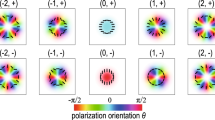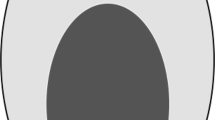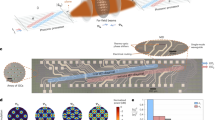Abstract
Wireless communications are a fundamental part of modern information infrastructure. But wireless bandwidth is costly1, prompting a close examination of the data channels available using electromagnetic waves. Classically, radio communications have relied on one channel per frequency, although it is well understood that the two polarization states of planar waves2 allow two distinct information channels; techniques such as ‘polarization diversity’ already take advantage of this3. Recent work4,5,6,7 has shown that environments with scattering, such as urban areas or indoors, also possess independent spatial channels that can be used to enhance capacity greatly. In either case, the relevant signal processing techniques come under the heading of ‘multiple-input/multiple-output’ communications, because multiple antennae are required to access the polarization or spatial channels. Here we show that, in a scattering environment, an extra factor of three in channel capacity can be obtained, relative to the conventional limit using dual-polarized radio signals. The extra capacity arises because there are six distinguishable electric and magnetic states of polarization at a given point, rather than two as is usually assumed.
This is a preview of subscription content, access via your institution
Access options
Subscribe to this journal
Receive 51 print issues and online access
$199.00 per year
only $3.90 per issue
Buy this article
- Purchase on Springer Link
- Instant access to full article PDF
Prices may be subject to local taxes which are calculated during checkout




Similar content being viewed by others
References
Andrews, E. L. $50 billion for German wireless licenses. The New York Times 18 August (2000).
Jackson, J. D. Classical Electrodynamics (John Wiley, New York, 1975 ).
Singer, A. Space vs. polarization diversity. Wireless Rev. 15, 164–166 (1998).
Winters, J. H. On the capacity of radio communication systems with diversity in a rayleigh fading environment. IEEE J. Selected Areas Commun. Vol. SAC-5, 871–878 (1987).
Foschini, G. J. & Gans, M. J. On limits of wireless communications in a fading environment when using multiple antennas. Wireless Pers. Commun. 6, 311–335 (1998).
Telatar, I. E. Capacity of multi-antenna gaussian channels. Eur. Trans. Telecommun. 10, 585–595 ( 1999).
Moustakas, A. L., Baranger, H. U., Balents, L., Sengupta, A. M. & Simon, S. Communication through a diffusive medium: Coherence and capacity. Science 287, 287–290 (2000).
deCarvalho, R., Mitra, P. P. & Andrews, M. R. in National Radio Science Meeting 84 (International Union of Radio Science, National Academy of Sciences, 2000).
Morgan, M. & Evans, W. Synthesis and analysis of elliptic polarization loci in terms of space-quadrature sinusoidal components. Proc. IRE 39, 552–556 ( 1951).
Hatke, G. F. in Twenty-seventh Asilomar Conference on Signals, Systems & Computers 1365–1369 (IEEE Computer Society Press, Los Alamitos, California, 1993).
Afraimovich, E. L., Chernukhov, V. V., Kobzar, V. A. & Palamartchouk, K. S. Determining polarization parameters and angles of arrival of hf radio signals using three mutually orthogonal antennas. Radio Sci. 34, 1217–1225 (1999).
Kraus, J. D. Antennas 2nd edn 725–726 (McGraw Hill, Boston, 1988).
Lee, W. C. Y. Theoretical and experimental study of the properties of the signal from an energy-density mobile-radio antenna. IEEE Trans. 1, 25–32 (1967).
Acknowledgements
This work is supported by internal funding at Bell Labs, Lucent Technologies. We are grateful to W. M. MacDonald for his assistance in characterizing our antenna's radiation patterns, and to M. J. Gans for his insights and discussions concerning magnetic polarization.
Author information
Authors and Affiliations
Corresponding author
Rights and permissions
About this article
Cite this article
Andrews, M., Mitra, P. & deCarvalho, R. Tripling the capacity of wireless communications using electromagnetic polarization. Nature 409, 316–318 (2001). https://doi.org/10.1038/35053015
Received:
Accepted:
Issue Date:
DOI: https://doi.org/10.1038/35053015
Comments
By submitting a comment you agree to abide by our Terms and Community Guidelines. If you find something abusive or that does not comply with our terms or guidelines please flag it as inappropriate.



